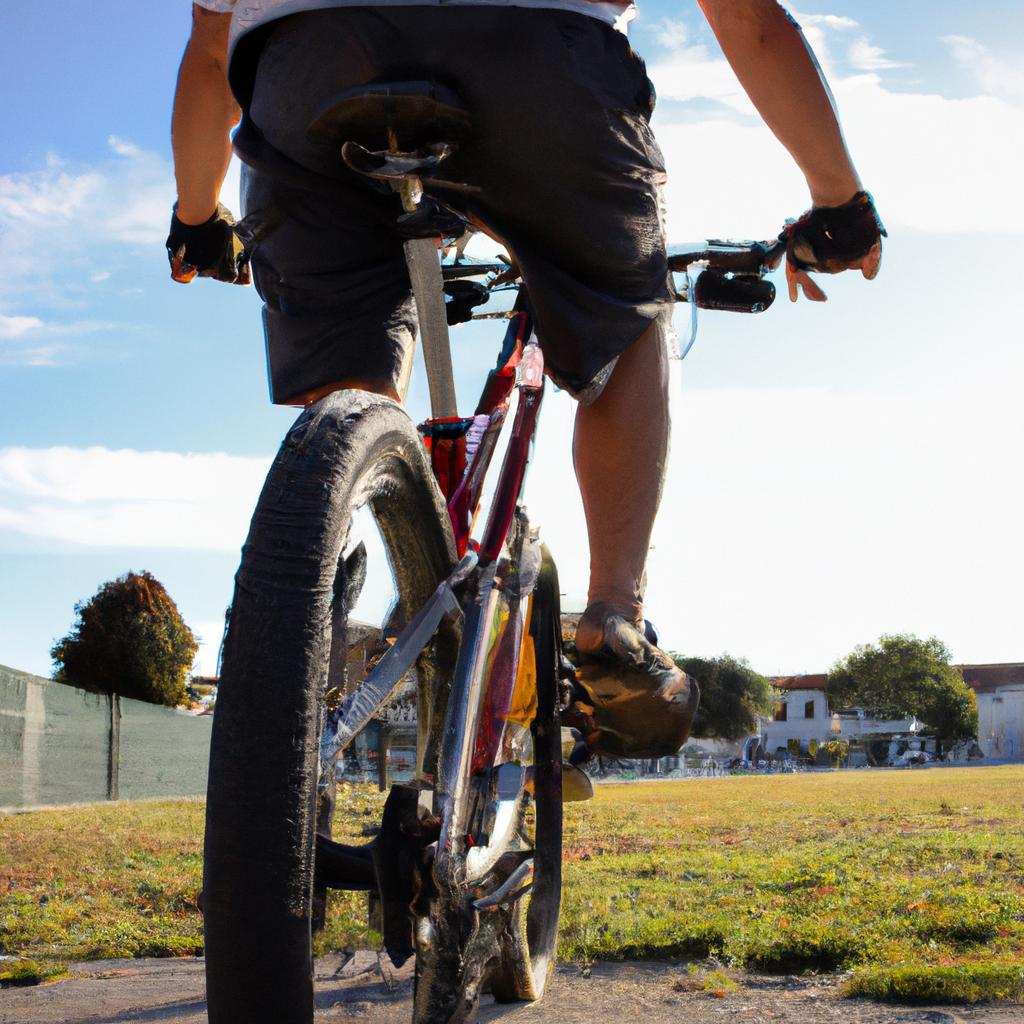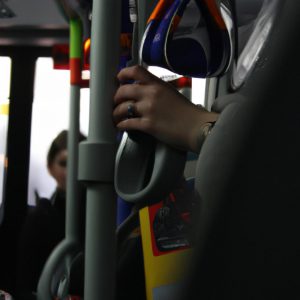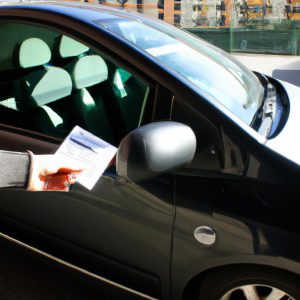Bicycles: Transportation Options in the Travel Directory

Bicycles have long been recognized as a convenient and eco-friendly means of transportation, providing individuals with an efficient way to navigate urban environments. In recent years, bicycles have gained significant popularity as a viable alternative to traditional modes of travel due to their numerous benefits. For instance, consider the case study of Sarah, a city dweller who relies solely on her bicycle for commuting purposes. By utilizing her bicycle instead of driving or using public transportation, she not only saves money on fuel costs but also reduces carbon emissions that contribute to air pollution.
In addition to its environmental advantages, the use of bicycles presents various health benefits for individuals. Regular cycling has been shown to improve cardiovascular fitness, increase muscle strength and flexibility, and help manage weight effectively. Furthermore, cycling promotes mental well-being by reducing stress levels and enhancing mood through the release of endorphins. With these compelling reasons in mind, it is no wonder that bicycles are increasingly being embraced as a preferred mode of transportation among travelers around the world.
This article aims to explore bicycles as a transportation option within the context of the Travel Directory. It will delve into the benefits and drawbacks associated with choosing this mode of travel while considering practical considerations such as infrastructure availability and safety measures. Moreover, it will provide insights into how individuals can incorporate cycling into their travel plans and make the most of their biking experiences. Whether it’s exploring a new city on two wheels or embarking on an adventurous bike tour, there are various ways to incorporate cycling into one’s travel itinerary.
One key aspect to consider when choosing bicycles as a mode of transportation is the availability of infrastructure. Many cities around the world have invested in building dedicated bicycle lanes and paths, making it safer and more convenient for cyclists to navigate urban areas. In addition, some cities offer bike-sharing programs, allowing travelers to easily rent bicycles for short-term use. It is important to research and plan routes that take advantage of these infrastructure options to ensure a smooth and enjoyable biking experience.
Safety is another crucial consideration when using bicycles for travel. Wearing appropriate safety gear such as helmets and reflective clothing is essential for protecting oneself while on the road. Additionally, familiarizing oneself with local traffic laws and regulations is important to ensure compliance and minimize potential risks.
When incorporating cycling into travel plans, it is also important to consider the duration and distance of the journey. Longer trips may require additional planning for rest stops, accommodations, and carrying necessary supplies such as water and snacks. Researching bike-friendly routes or seeking guidance from local cycling communities can greatly enhance the overall experience.
Furthermore, travelers should be mindful of weather conditions when planning their biking adventures. Extreme temperatures or heavy rainfall can significantly impact both comfort and safety while cycling. It is advisable to check weather forecasts beforehand and adjust plans accordingly.
Lastly, embracing a sustainable mindset goes hand-in-hand with choosing bicycles as a transportation option. Travelers can support local businesses by opting for eco-friendly accommodations that provide bicycle storage facilities or promote bike tourism initiatives.
In conclusion, incorporating bicycles into travel plans offers numerous benefits including environmental sustainability, improved health outcomes, and unique opportunities for exploration. By considering practical factors such as infrastructure availability, safety measures, trip duration, weather conditions, and sustainable choices, individuals can make the most of their biking experiences. Whether it’s a short commute or an adventurous bike tour, bicycles have proven to be a convenient and eco-friendly mode of travel that continues to gain popularity worldwide.
Benefits of using bicycles for transportation
Benefits of using bicycles for transportation
Imagine a bustling city where rush hour traffic is at its peak. Cars are lined up bumper to bumper, emitting exhaust fumes that contribute to pollution and congestion. In the midst of this chaos, imagine an alternative mode of transportation – bicycles. Not only do they provide a means of commuting from one point to another, but they also offer numerous benefits that make them a viable option for sustainable travel.
Increased Physical Activity:
One significant advantage of using bicycles as a mode of transportation is the opportunity it presents for increased physical activity. Unlike other forms of transport, such as cars or buses, cycling requires continuous pedaling, engaging various muscle groups in the process. Research has shown that regular physical exercise can improve cardiovascular health, reduce stress levels, and enhance overall well-being.
Environmental Sustainability:
In today’s world, environmental concerns have become increasingly important. Bicycles offer a more eco-friendly method of transportation compared to traditional vehicles powered by fossil fuels. By opting for bikes over cars or motorcycles, individuals can significantly reduce carbon emissions and minimize their ecological footprint. This small change on an individual level can collectively make a substantial impact on reducing air pollution and combating climate change.
Cost-effectiveness:
Another compelling reason to consider bicycles as a primary means of transportation is cost-effectiveness. Owning and maintaining a bike comes with minimal expenses when compared to fuel costs or public transportation fees. Additionally, bicycles require fewer resources and infrastructure investments than roads or parking spaces dedicated to automobiles. For those looking to save money while still enjoying efficient mobility options, biking proves to be an economically prudent choice.
Improved Mental Well-being:
Apart from the physical benefits mentioned earlier, cycling also positively impacts mental well-being. Engaging in outdoor activities like bicycling exposes individuals to fresh air and sunlight which can boost mood and alleviate symptoms associated with anxiety and depression. Furthermore, riding bicycles fosters a sense of freedom and independence; the ability to navigate through traffic or explore scenic routes can be both exhilarating and therapeutic.
To further emphasize the advantages of bicycles, consider the following emotional responses:
- Freedom: Experience a sense of liberation as you effortlessly pedal your way through traffic.
- Connection with Nature: Feel closer to nature while cycling along picturesque paths and enjoying the beauty of your surroundings.
- Energy Efficiency: Appreciate how using human power instead of fossil fuels contributes to a cleaner and more sustainable environment.
- Community Building: Join a vibrant community of cyclists who share a passion for healthier lifestyles and eco-conscious choices.
Furthermore, referring to the table below illustrates some additional benefits:
| Benefits | Description | Example |
|---|---|---|
| Physical Health | Cycling improves cardiovascular fitness. | Increased stamina |
| Environmental Impact | Bicycles reduce carbon emissions and air pollution. | Less reliance on fossil fuels |
| Financial Savings | Reduced expenses compared to other modes of transport. | Lower transportation costs |
| Mental Well-being | Riding bikes can alleviate stress and improve mental health. | Enhanced mood |
In conclusion, considering the environmental, physical, financial, and mental well-being benefits discussed above, it becomes evident that incorporating bicycles into our daily travel routines is not only advantageous but also enjoyable. With these compelling reasons in mind, let us now delve into essential tips for choosing the right bicycle for travel
Tips for choosing the right bicycle for travel
Case Study: Imagine Sarah, an avid traveler who recently embarked on a journey through Europe. Seeking alternative modes of transportation, she decided to use bicycles for her daily commute and sightseeing adventures in various cities. Not only did this choice provide her with convenient mobility, but it also allowed her to immerse herself in the local culture and experience firsthand the many benefits of using bicycles as a sustainable means of travel.
Using a bicycle offers numerous advantages that go beyond its role as a mode of transportation. Here are some key reasons why more travelers are choosing bicycles:
-
Environmentally Friendly:
- Reduced carbon emissions contribute to cleaner air quality.
- Decreased reliance on fossil fuels helps combat climate change.
- Preservation of natural landscapes by minimizing harmful environmental impacts.
-
Physical Health Benefits:
- Regular cycling improves cardiovascular fitness and strengthens muscles.
- Enhances overall well-being by promoting mental health and reducing stress levels.
- Increased physical activity supports weight management and boosts energy levels.
-
Cost-Effective Solution:
- Lower expenses compared to traditional forms of transport such as taxis or rental cars.
- Minimal maintenance costs when compared to vehicle ownership.
- No need for fuel purchases reduces expenditure during travels.
-
Cultural Immersion:
|—|—|—|
| Connecting with Locals | Exploration at Your Pace | Hidden Gems Discovery |
|---|---|---|
| Engage with locals while riding through neighborhoods. | Set your own itinerary and explore off-the-beaten-path locations. | Discover hidden gems inaccessible by other means of transport. |
By embracing these aspects, travelers like Sarah can enjoy not only efficient commuting but also enriching experiences that foster cultural understanding and personal growth.
As we delve deeper into the world of bicycle travel, let us now turn our attention to popular cycling routes for travelers seeking adventure, scenic beauty, and memorable experiences.
Popular cycling routes for travelers
Section Title: Choosing the Right Bicycle for Travel
Having discussed some valuable tips on selecting a suitable bicycle for your travel adventures, let’s now delve into popular cycling routes that have captivated countless travelers. But before we embark on exploring these scenic pathways, it is essential to understand how crucial choosing the right bicycle can be.
Imagine you are planning a cross-country cycling journey through rugged terrains and picturesque landscapes. As you navigate through diverse environments, ranging from mountainous trails to bustling city streets, having a reliable and appropriate bicycle becomes paramount. Let us explore the factors to consider when selecting the ideal bicycle for your travel needs.
Factors to Consider:
When deciding which type of bicycle will best suit your travel requirements, several key considerations should guide your decision-making process:
- Terrain: Determine whether you’ll primarily ride on paved roads or venture off-road onto gravel paths or rough terrain.
- Distance: Evaluate the length of your intended journeys; shorter trips may warrant different bicycles than long-distance expeditions.
- Comfort: Prioritize ergonomic features such as an adjustable seat height, handlebar positions, and shock absorbers to ensure maximum comfort during extended rides.
- Storage Capacity: Assess the amount of gear you plan to carry with you – panniers (saddlebags), front racks, or trailers can significantly enhance storage capacity.
- Increased confidence in tackling various terrains
- Enhanced physical fitness and well-being
- Unique opportunity for immersive cultural experiences
- Unforgettable memories created through shared adventures
Emotional Table:
| Mountain Bikes | Road Bikes | Touring Bikes | |
|---|---|---|---|
| Pros | Versatile | Speedy | Reliable |
| Sturdy | Lightweight | Durable | |
| Cons | Heavier | Less stable | Slower |
| Limited speed | Less comfort | Less agility |
By carefully considering the terrain, distance, comfort, and storage capacity requirements of your cycling adventure, you can select a bicycle that will optimize your travel experience. Armed with this knowledge, let us now transition into exploring how to maintain and repair bicycles while traveling.
Understanding the importance of choosing the right bicycle is only part of ensuring an enjoyable journey. Equally vital is acquiring the skills necessary to keep your bicycle in optimal condition throughout your travels.
How to maintain and repair bicycles while traveling
Section Title: Exploring Scenic Routes on a Bicycle
Imagine yourself embarking on an adventurous journey through picturesque landscapes, with the wind in your hair and the freedom to explore at your own pace. Cycling has emerged as one of the most popular forms of transportation for travelers seeking unique experiences. In this section, we will delve into some of the world’s most renowned cycling routes that offer breathtaking views and unforgettable adventures.
One such route is the famous EuroVelo 6, which spans across ten European countries from France to Romania. This captivating path follows three major rivers – the Loire, Danube, and Rhine – offering cyclists stunning vistas of medieval castles, vineyards, charming towns, and ancient ruins along its course. As you pedal through diverse cultures and landscapes, immerse yourself in Europe’s rich history while enjoying the tranquility that only nature can provide.
To further ignite your wanderlust for cycling exploration, here are four key reasons why these scenic routes deserve a spot on every traveler’s bucket list:
- Immersive Cultural Experience: By traversing these cycling paths, you have the opportunity to engage directly with local communities, sample regional cuisines, and witness traditional customs firsthand.
- Physical Well-being: Not only does cycling allow you to enjoy unparalleled natural beauty but also provides numerous health benefits such as improved cardiovascular fitness and increased endurance.
- Eco-friendly Travel Choice: Opting for bicycle travel contributes significantly towards reducing carbon emissions and preserving our planet’s fragile ecosystems.
- Unforgettable Memories: The sense of accomplishment gained from conquering challenging terrains coupled with awe-inspiring sceneries make these journeys truly remarkable.
Now let us take a closer look at how some of these remarkable cycling routes compare:
| Route | Countries | Length (km) | Highlights |
|---|---|---|---|
| EuroVelo 15 | Switzerland, France | 1,230 | Rhine River views, vineyards, and quaint Alsace villages |
| Great Divide | USA | 4,400 | Rocky Mountains, epic wilderness landscapes |
| Munda Biddi | Australia | 1,000 | Ancient forests, wildlife encounters |
| Iron Curtain Trail | Multiple | ~10,400 | Historic sites from the Cold War era |
As you can see from this table, these routes offer diverse experiences catering to different interests and preferences. Whether it’s cycling along the majestic Rhine or immersing yourself in the untamed beauty of the Great Divide route in the USA, there is a path for every adventurer.
In our next section on “Bicycle safety tips for travelers,” we will provide essential guidelines to ensure your cycling journey remains enjoyable and accident-free. By adhering to proper safety measures while exploring these scenic routes, you can fully embrace the freedom and joy that bicycle travel offers without compromising your well-being or that of others around you.
Bicycle safety tips for travelers
Bicycles: Transportation Options in the Travel Directory
Section H2: How to maintain and repair bicycles while traveling
Moving on from discussing bicycle maintenance, it is crucial for travelers to prioritize their safety when exploring new destinations by bike. By adhering to certain tips and precautions, cyclists can ensure a smooth and secure experience during their journeys.
Paragraph 1:
To illustrate the importance of bicycle safety, consider the case of Emily, an avid traveler who decided to explore Amsterdam’s scenic streets by bike. Equipped with her trusty two-wheeler, she set off eagerly but soon encountered challenges due to unfamiliar traffic rules and congested paths. However, by following essential safety measures such as wearing a helmet, using proper hand signals, and obeying local cycling regulations, Emily was able to navigate through the city safely.
- Always wear a properly fitted helmet.
- Observe and follow traffic laws specific to cycling.
- Use hand signals when turning or changing lanes.
- Be cautious around pedestrians and yield accordingly.
Cycling Safety Tips:
- Stay alert and aware of your surroundings at all times.
- Avoid distractions such as using mobile devices while riding.
- Maintain a safe distance from other vehicles on the road.
- Ensure that your bicycle is in good condition before each ride.
Paragraph 2:
| Potential Hazards | Description | Preventive Measures |
|---|---|---|
| Uneven surfaces | Irregular roads or paths | Proceed slowly; check speed before encountering surface |
| Car doors | Opening suddenly from parked vehicles | Ride further away from cars; watch for occupants |
| Poor visibility | Dimly lit areas or adverse weather conditions | Use lights and reflective gear; wear bright clothing |
| Pedestrians | Unpredictable movements | Slow down when approaching pedestrians |
Paragraph 3:
By emphasizing safety throughout their cycling adventures, travelers can be confident in exploring cities and landmarks by bicycle. The upcoming section will delve into the advantages of using bicycles as a means to discover new destinations while enjoying the freedom and flexibility they offer.
With a solid understanding of bicycle safety measures, let us now explore how bicycles can enhance your travel experiences by providing an alternative mode of transportation for discovering cities and landmarks.
Exploring cities and landmarks by bicycle
Bicycles: Transportation Options in the Travel Directory
Continuing our exploration of bicycles as a transportation option for travelers, let us delve into the exciting world of exploring cities and landmarks on two wheels. To illustrate the advantages of this mode of travel, consider this hypothetical scenario: Alex, a curious traveler with a passion for history, finds themselves in Paris. With limited time and an eagerness to experience the city’s rich culture, Alex decides to embark on a bicycle adventure through its enchanting streets.
When exploring cities and landmarks by bicycle, several benefits become apparent. Firstly, cycling provides unparalleled flexibility compared to other modes of transport. Cyclists can effortlessly navigate narrow alleys or pedestrian-only zones that might be inaccessible to motor vehicles. This freedom allows travelers like Alex to discover hidden gems off the beaten path and uncover unique perspectives often missed by conventional sightseeing methods.
Additionally, traveling by bike offers environmental advantages over traditional transportation options. By reducing reliance on fossil fuels and minimizing pollution emissions, cyclists contribute positively towards sustainable tourism practices. For environmentally conscious individuals like Alex, pedaling through historic neighborhoods not only connects them deeper with their surroundings but also promotes eco-friendly travel choices that preserve these cultural sites for future generations.
To further emphasize the appeal of exploring cities and landmarks by bicycle, let us consider some emotional responses associated with this mode of travel:
- Sense of liberation: Cycling through bustling streets induces a feeling of liberation as one glides past congested traffic.
- Connection with surroundings: Pedaling at a leisurely pace enables keen observation and appreciation of architectural marvels along the way.
- Intimate experiences: Biking allows travelers to immerse themselves fully in local culture while experiencing personal interactions with residents.
- Joyful memories: The physical exertion involved in cycling stimulates endorphin release, resulting in positive emotions and lasting memories.
Furthermore, the following table provides a glimpse into how exploring cities by bicycle can evoke different emotional responses:
| Emotion | Description |
|---|---|
| Excitement | The thrill of discovering vibrant neighborhoods and encountering unexpected surprises. |
| Serenity | A sense of tranquility experienced when pedaling through serene parks or along peaceful riverfronts. |
| Adventure | Feeling adventurous while navigating unfamiliar streets and embarking on spontaneous detours. |
| Wonder | The awe-inspiring moments when cyclists stumble upon breathtaking landmarks not found in guidebooks. |
In conclusion, exploring cities and landmarks by bicycle offers travelers like Alex an extraordinary way to engage with their surroundings. With its flexibility, environmental benefits, and ability to evoke positive emotions, cycling presents a unique opportunity for unforgettable experiences during one’s travels. So next time you find yourself in a new city or near remarkable landmarks, consider hopping on a bike and immersing yourself in the adventure that awaits around every corner.








